Blog entries for 2014
December 8, 2014
Supporting the Second Harvest holiday food drive
We sorted donations, packed boxes of food, and organized the warehouse where Second Harvest stages its food distribution, and I can honestly say that everyone who participated got a lot out of the experience. John tells me that UCSC has consistently been the third-highest contributor to the food drive behind Twin Lakes Church and Plantronics, which is a point of pride for the campus community.
As the food drive enters its final phase, please consider donating nonperishable food; donation barrels are located around campus. John also reminded me of the impact of cash donations: For every dollar donated, Second Harvest is able to distribute four healthy meals to people in our community.
The Staff Advisory Board and Academic Senate are great partners in this community effort, and I thank them for helping to mobilize the campus community around this important and worthwhile cause. Happy holidays!
Comments or questions? Write to chancellor@ucsc.edu and put "Harvest" in the subject line.
November 13, 2014
Stellar performances mark new play, Birth of Stars
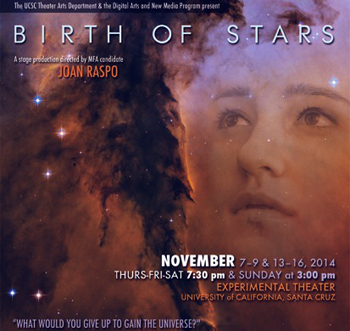
Last Friday, I had the privilege of attending the world premier of Birth of Stars in our Experimental Theatre. What a show! I say, get your tickets while you can!
This play was written by Michael Chemers, associate professor of dramatic literature and chair of Digital Arts and New Media, along with James Bierman of Theater Arts and Mark Krumholz of the Astronomy Department, who also served as the scientific advisor for the play.
The play is about a 14-year-old-girl, a scientific prodigy bullied by her classmates but befriended by an aging professor who appreciates her brilliant mind even as his own scientific productivity is in decline. The acting in both of these parts was excellent. The play follows the young woman’s interactions with her schoolmates, as well as her scientific musings about why stars seem to be limited in terms of how much mass they can contain. I won't be a spoiler, but rest assured, the plot is compelling. So are the stunning visual effects. The play was scientifically accurate, extremely well-written, and very well acted.
Afterwards, Michael, Mark, Jim, and I gathered on stage for a "talkback," a panel discussion about the play. I was stunned by how well astronomy had been incorporated into the production. Michael, Mark, and Jim described the months-long process of collaboration that yielded the show.
Again, without giving too much away, I thought this play could have been entitled Birth and Death of Stars for its compelling depictions of both the beginning and the end of impressive scientific careers. I found myself wondering what the young woman would be like in 50+ years as her own career comes to a close. Overall, this was an excellent play with wonderful performances. Go see it!
Comments or questions? Write to chancellor@ucsc.edu and put Stars" in the subject line.
November 12, 2014
Freedom of speech must apply to all speakers
The controversy at UC Berkeley that followed the request to invite—and then disinvite—Bill Maher to deliver commencement remarks in December leaves me unmoved. Increasingly in recent years, we've seen controversies like this break out on campuses across the country as critics of various speakers seek to retract invitations and deny invitees high-visibility speaking opportunities. I remain convinced that the only way to protect the fundamental freedom of speech is to support every individual's right to express his or her views. Moreover, I believe college and university campuses have a particular obligation to provide platforms for diverse viewpoints.
That doesn't mean I'll be swayed by the views of particular speakers, or even that I'll enjoy hearing what they have to say. But I have always felt strongly that everyone deserves the right to speak, and those who want to listen deserve that opportunity, as well.
I remember one particular anti-war demonstration at UC San Diego during my years there as a graduate student. A large, angry crowd had formed in Revelle Plaza, the campus's central gathering spot, and the chancellor was trying to address the crowd. I was strongly opposed to the war and had, in fact, helped organize the first anti-war protest in San Diego (which at the time was a politically conservative city). Chancellor William McGill was known for engaging with students during frequent noontime protests, but on this day, the crowd shouted him down and he wasn't allowed to speak.
I remember a friend of mine, a fellow grad student, calling from the edge of the crowd to let McGill speak: "He's been hearing us, so let's hear what he has to say." At that, the crowd quieted, and McGill was able to address the gathering.
Years later, McGill wrote about the encounter in his memoir The Year of the Monkey: Revolt on Campus 1968-69. He felt it was wrong that he'd been shouted down, not because he was chancellor but because he deserved to be heard, just like anyone else. He was grateful for the lone voice of support he'd heard that afternoon. And I was pleased to tell him many years later who that lone voice was.
Over the years, I've appreciated others who have stepped up in a variety of venues to defend the rights of those who wish to be heard. Personally, I have tried to keep the channels of communication open, even—or perhaps especially—during raucous meetings, whether it is a student forum, a senate meeting, or even a Regents meeting. As chancellor, I have been the target of those whose goal was to silence me. Although I have occasionally seethed internally during tense exchanges, I believe fundamentally in the value of public debate. Far more often, I have felt proud of my colleagues and our students as they have engaged in the respectful exchange of ideas. I've always felt that the more we communicate, the better.
Comments or questions? Write to chancellor@ucsc.edu and put "Controversy" in the subject line.
October 16, 2014
My Loma Prieta story: Stuck in an elevator and tossed around like a pinball

This photo of earthquake damage on Summit Road was taken by Gary Griggs, distinguished professor of Earth and planetary sciences.
The 25th anniversary of the Loma Prieta earthquake certainly brings back memories.
I was returning to my office in Natural Sciences II and, feeling a bit lazy, I decided to take the elevator up to the third floor. That's when the magnitude-7.1 earthquake struck. I was tossed from wall to wall inside that freight elevator like a pinball. It was shocking, trying to fend off the walls I was being thrown against. Then, as suddenly as it started, it was over.
But the campus and the elevator had lost power, so I was trapped alone. I was terrified that the elevator cable would break, especially if an aftershock struck. I tried to figure out whether I would be better off standing, jumping, or lying flat on the floor if the cable broke. (Unbeknownst to me, it was a hydraulic elevator with no cable, so it was virtually immune to a catastrophic break.)
It was pretty unpleasant in that dark little box. There was no light because the campus had lost power, and in the darkness, the building's emergency alarms were blaring -- they were really loud! I felt so alone. Then the first aftershock struck, and I was tossed around again.
I did use the emergency phone to call campus dispatch. When I asked the woman who answered whether that had been an earthquake, she said, "Where have you been?" I had to explain that I was stuck in the elevator the whole time and would appreciate getting out. She told me to wait patiently because there were emergencies all over campus. Eventually, she came back on the line to ask me if I was a university employee. To this day, I suspect she was trying to determine if I had next-of-kin records on file in case the worst happened.
Finally, after about 45 minutes, the power came back on. I pressed 1, and sure enough, the elevator returned to the ground floor and the door opened! Somehow, I expected cheering crowds, but there was no one there. I propped the door open and actually went back into the elevator to tell emergency services that I was out. I soon saw one of our students, who told me that the World Series at Candlestick Park had been stopped because of the quake.
I drove down the hill to my home on Escalona Drive and told my wife that I had the best excuse she'd ever heard for being late to dinner. Like most houses in Santa Cruz, we lost our chimney in the quake, but fortunately, the house was still standing. My wife's study on the second floor, which had bookshelves on every square foot of wall space, was inaccessible because every single book had all fallen and a pile was blocking the door. I had to force the door open by a few inches and toss books to the other side of the room to clear a path and get in.
All of Santa Cruz was without power and phone service for several days. The next day, the Safeway on Mission Street opened for something like six customers at a time. I waited for hours in a line that was many blocks long. Almost everyone was there to buy water or batteries. I was on a mission to buy diapers, because we had two little ones at the time!
It turned out that Nat Sci II was severely damaged in the quake. In fact, we later learned that had the earthquake lasted a few more seconds, the building would have collapsed. It was several weeks before we were able to safely occupy the building again. They did some temporary shoring of the building, which lasted for a couple of years. Finally, we all moved to Kerr Hall so the building could be fixed. The flying buttresses they used to shore up the building are a key feature even today.
Comments or questions? Write to chancellor@ucsc.edu and put "Earthquake" in the subject line.
September 24, 2014
We need a Staff Advisor to the Regents from UC Santa Cruz
It's always a pleasure to host the staff advisors to the UC Regents on campus. Staff Advisor Donna Coyne and Staff Advisor Designate Deidre Acker were on campus Monday. They met with our Staff Advisory Board and the UCSC Academic Business Officers Group, attended the SAB lunch forum with staff, and had dinner with me.
Salary, workload, and succession planning were hot topics at the forum, and Donna and De listened closely. I'm proud to have helped get these staff advisor positions established. Now my goal is to have a UC Santa Cruz staff member serve in this key role! It's a big job that involves traveling to every campus, attending Regents meetings, and going to meetings at the Office of the President. And it comes on top of an existing job, of course.
But staff advisors can make a difference, and having a UCSC representative would raise our campus's visibility before the Regents. I'm reminded that we've yet to have a student Regent, and only two Santa Cruz faculty members have served as representatives to the Regents (Michael Cowan and yours truly).
Please help me advertise this opportunity among our talented and hard-working staff. The application period opens in January. Really, it's time!
Comments or questions? Write to chancellor@ucsc.edu and put "Advisors" in the subject line
September 11, 2014
Faculty and students speak from the heart about UC Santa Cruz
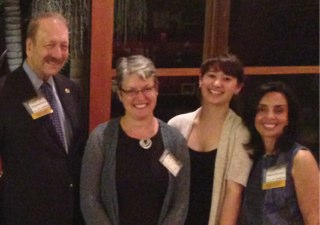
Professor Shelley Stamp, undergraduate Jasmine Lee Ehrhardt, and Ramyne Spire (far right) joined me at a reception for friends of the campus hosted by Ramyne and her husband, UC Santa Cruz Trustee Garry Spire.
Wow, our faculty and students are this campus's best ambassadors. I was reminded of that over the weekend, when UC Santa Cruz trustee Garry Spire and his wife Ramyne hosted a reception in Los Angeles for parents, alumni, and friends of the campus.
On the program were Shelley Stamp, a professor of film and digital media, and undergraduate Jasmine Lee Ehrhardt. They each gave a short talk, and the audience was blown away by what they heard.
Shelley's work is fascinating. Her research focuses on the role of women in early Hollywood. I was telling old friends about her work just this morning. I had no idea that the top-grossing film of 1916 was directed by a woman, Lois Weber. Her film, Where Are My Children?, was about abortion and birth control. Weber was one of the top directors, along with Cecil B. DeMille and D. W. Griffith, and you have to wonder how her name has been lost to history. Women dominated many roles in Hollywood—as screenwriters, directors, and producers—and the majority of moviegoers were women, too. Shelley has been at the forefront of the effort to reclaim this lost history for two decades. Today, joined by a handful of scholars around the country, she remains the authoritative voice.
To be honest, I didn't envy Jasmine having to follow Shelley, but she was up to the task. A junior double majoring in literature and film, Jasmine described what her years at UC Santa Cruz have meant to her in deeply personal terms. She talked about how her classroom experiences have given meaning to her mixed-race identity and how Shelley's classes have built upon that sense of identity. College has awakened something inside her she didn't know was there, and her gratitude was palpable. When she was overcome by emotion and shed a few tears, the audience was as swept up in the emotion of the moment as she was. It was truly moving.
I'm grateful to Shelley and Jasmine for agreeing to represent the campus at this event. We are hosting a series of receptions this fall that are designed to get the word out about what we're doing at UC Santa Cruz and to build support for our three-part mission of teaching, research, and public service. With ambassadors like Shelley and Jasmine, we're off to a great start.
Comments or questions? Write to chancellor@ucsc.edu and put "Spire" in the subject line
August 19, 2014
Coastal Biology building will be a gem

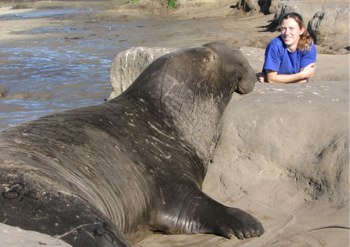
The Coastal Biology building will be a tremendous resource, supporting the work of researchers like graduate student Sarah Peterson, who is studying the accumulation of mercury, PCBs, and DDT in northern elephant seals. (NMFS Permit 14636)
At long last, the students, faculty, and staff of the Ecology and Evolutionary Biology Department will be together again! We will break ground on the Coastal Biology building at Long Marine Lab this fall, with a planned move-in date of fall 2016.
It's been a long time since the campus has had a new building come online, and this one will bear great intellectual fruit by reuniting the department. Sharing a roof will further energize this group, and state-of-the-art facilities will support their great work.
The Central Coast is home to a concentration of marine science expertise. Around the bay, there are great collaborations taking place among researchers affiliated with UC Santa Cruz, the Monterey Bay Aquarium, Cal State Monterey Bay, and Stanford, among others. This building will expand our ability to partner with others, and its proximity to adjacent governmental and nonprofit organizations will foster our relationships with the National Marine Fisheries Service, the California Department of Fish and Wildlife, and the Nature Conservancy.
The move will free up much-needed space on campus, but students will be the biggest winners. Every time I visit Long Marine Laboratory, I am struck by the amazing work taking place there—and by the significant contributions our students are making. They pay their dues cleaning marine mammal tanks and performing basic chores, but they work their way up to caring for animals, helping with training, and doing research with the seals, sea lions, otters, and others. It's so unique, and the students get so much out of it. That's what we're all about—giving students experiences that change their lives.
Great facilities are part of what makes it all possible. Buildings truly matter. Congratulations to all who worked so hard to make this one a reality.
Comments or questions? Write to chancellor@ucsc.edu and put "Coastal" in the subject line
August 18, 2014
Touring Levi's Stadium
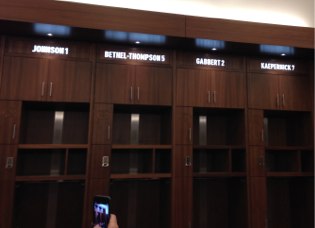
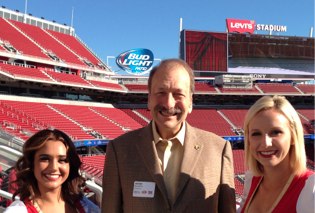
I wasn't the only person snapping photos of the players' elegant locker room (above). And what's a visit to the stadium without a photo op with the 49ers' Gold Rush Cheerleaders?
Every August, the Silicon Valley Leadership Group hosts a barbeque, and this year's took place at the new Levi's Stadium in Santa Clara. What a facility! No expense was spared. The luxury boxes are unbelievable, as are the locker rooms. There are enough solar panels to power a small city. The latest technology has been integrated into everything, too, including the fan experience. Ticket holders will download an app to enter the stadium, and the same app will enable them to watch instant replays on their smart phones. Fans can even order food and drinks from the app, and it'll be delivered right to them--no more missing the action. Wi-fi is everywhere, of course, as are iPhone charging stations.
I got a kick out of seeing it, and it was a bonus to run into Santa Cruz County Treasurer Fred Keeley and two alumni: California Secretary for Natural Resources John Laird, who'd spent all day on the phone securing support for the water bond proposal that will appear on the November ballot, and former mayor of San Jose Ron Gonzalez, a UCSC trustee who's the president of the Hispanic Foundation of Silicon Valley. A welcome reminder that there are Banana Slugs everywhere!
Comments or questions? Write to chancellor@ucsc.edu and put "Stadium" in the subject line
July 15, 2014
Bidding farewell to staff colleagues

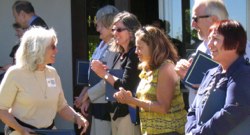
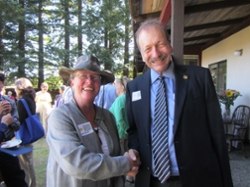
It was all smiles at the reception for new retirees, including Sue Grimes, middle, and Susie Bower, lower.
I'll admit it: Every time a long-serving colleague retires, I feel devastated. Last year, my executive assistant Maurene Catto retired. This year's wave of retirees includes several staff members with whom I've worked closely over many years, including campus counsel Carole Rossi, sexual harassment officer Rita Walker, budget director Karen Eckert, and campus spokesman Jim Burns. Of course, for each of these, there are many other new retirees I don't know well or perhaps have never met.
The truth is, there is always turnover. It's the natural way of things. I'm happy for this fresh crop of retirees. And I'm happy the campus has benefited from their dedication, talent, and service (though I wonder why they're leaving so soon. After all, I recently began my 43rd year on campus!).
Whether someone works behind the scenes, as Karen Eckert did for more than 30 years, or in front of the television cameras as Jim Burns did, each individual makes a difference on this campus. And it's gratifying that many retired staff stay connected to the university. One group—the UC Santa Cruz Retirees Association—has just endowed a scholarship program for students who are military veterans. The endowment honors the memory of long-time staff member Bruce Lane, a project architect who was hired by founding chancellor Dean McHenry.
That endowment is a testament to the generosity and big hearts of the entire Banana Slug family. Congratulations to our newest retirees! Soon enough we'll be greeting newcomers who will follow in their footsteps. It is the way of things.
Comments or questions? Write to chancellor@ucsc.edu and put "Retirees" in the subject line
July 11, 2014
Five infrastructure issues facing Santa Cruz

The second annual luncheon with the Santa Cruz County Business Council attracted a big crowd, including many alumni.
Traffic, water, housing, internet connectivity, and workforce development. Those five topics were the focus of the second annual "Partners in Economic Vitality" luncheon with the Santa Cruz County Business Council and UC Santa Cruz on Tuesday.
Turnout was great—more than 100 people showed up, including local business owners, nonprofit administrators, elected officials, and faculty and staff from campus. A number of alumni were in the room: County Supervisor Zach Friend, Volunteer Center Executive Director Karen Delaney, realtors Lee Slaff, developer Doug Kaplan, Santa Cruz County Bank Vice President Mary Ann Carson, land use consultant Owen Lawlor, and Cruzio President Peggy Dolgenos.
Peggy Dolgenos was one of five speakers, each of whom did a great job discussing the challenges and opportunities in their areas. I learned something from each presenter. Peggy talked about internet access, and she was kind enough to acknowledge the campus's role bringing high-speed internet service—"dark fiber"—to the central coast, which I appreciated. But clearly, as a region, we have a ways to go. She likened dark fiber to a backbone, saying we need a coordinated strategy to build out the system of "pipes" that will extend service to remote and underserved areas. Zach Friend is championing a countywide "dig once" policy, which would capitalize on any road construction to simultaneously install cable infrastructure. Sounds smart to me.
Architect Mathew Thompson discussed the role of changing demographics in exacerbating the housing crunch and some needed changes in city and county policies; George Dondero of the Santa Cruz County Regional Transportation Commission discussed the traffic council report and what it could mean for the county in the next decade; and Kim Adamson of the Soquel Creek Water District emphasized that the multiple water districts in our county need to work together to solve our regional issues.
In my own remarks about higher education and workforce development, I reminded the audience that experts predict that California will face a shortfall of 1 million college graduates by 2025. I don't like that scenario and urged attendees to join me in asking the governor for more robust support for the University of California. If we don't make the case, I'm afraid we'll have no one to blame but ourselves.
Comments or questions? Write to chancellor@ucsc.edu and put "Business" in the subject line
June 24, 2014
Commencement highlights
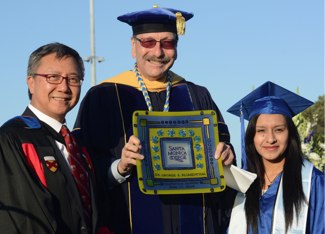
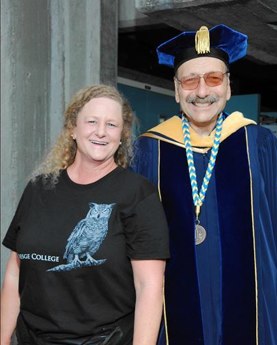
Top: Santa Monica College President Chui Tsang and graduate Lorena Carpinteyro joined me for a photo at the SMC commencement. Lorena is enrolling at UC Santa Cruz this fall. Below: Kresge College Programs Coordinator Pam Ackerman has worked on campus for 28 years. Thank you, Pam!
I was honored to give the commencement address at Santa Monica College, which has the distinction of sending more graduates to the University of California than any other community college in the state. Among the grads headed our way is Lorena Carpinteyro, who was kind enough to pose for a photo with SMC President Chui Tsang and me.
Santa Monica has held that top spot for 23 years, and I give them credit for making a concerted effort to encourage their students to transfer to the University of California. That path from community college to UC is important—and as costs rise, it's a smart way for students to meet the financial challenges of earning a four-year degree.
As I told SMC's graduates, I have no doubt that earning a college degree is the best investment they can make in their future. That diploma is more than a certificate on the wall; it's a testament to the discipline and persistence it takes to accomplish your goals.
As always, it was an honor to confer degrees on our own campus. At Kresge College, I met Programs Coordinator Pam Ackerman, who has worked on campus for 28 years. While we congratulate our most recent graduates, I want to congratulate Pam on her years of service and thank all our staff for their dedication and hard work. Go, Slugs!
Comments or questions? Write to chancellor@ucsc.edu and put "Commencement" in the subject line
May 2, 2014
We're on a roll
It's been a hot week—literally and figuratively—in Santa Cruz. Temperatures have been in the 80s for several days, and the good news keeps rolling in.
First, biologist Jim Estes and seismologist Thorne Lay were elected to the National Academy of Sciences on Tuesday—one of the highest honors in the country for scientists. Jim has done important work on the role of predators in ecosystems, including research on Central Coast sea otters. His insights apply to mountain lions, wolves, grizzly bears and other top predators, and they have widespread implications for conservation. Thorne analyzes seismic waves to learn about earthquakes and structural features of the deep earth, and he has developed methods to monitor compliance with nuclear test ban treaties.
Thorne was also named the recipient of the 2014 Harry Fielding Reid Medal from the Seismological Society of America this week—the top prize in seismology (one of the first awardees was Charles Richter, as in the "Richter scale" that measures the magnitude of earthquakes)--another outstanding honor.
I couldn't be more proud of these two eminent scientists, their work, and this well-deserved recognition. If we could "bottle" the campus culture that fosters this level of achievement—our custom blend of intellectual curiosity, interdisciplinary exploration, and a desire to make the world a better place—I think we could probably market it to other universities. Lucky for us, it's ours alone.
More evidence of UCSC's impact came in the very next day, when alum Sage Weil sold his data-storage company, Inktank, to Red Hat for $175 million. Sage developed his first working prototype as a grad student in computer science here, and the deal secures his technology's place in the open-source world.
Finally, for the third consecutive year, UC Santa Cruz was ranked one of the best young universities in the world by Times Higher Education. We were ranked 2nd among U.S. universities under the age of 50, and 11th overall. The bulk of the ranking is based on performance in three areas we care about deeply: research, citations, and teaching; additional factors include international outlook and industry income.
This is an honor we won't receive next year, when we celebrate our 50th year as a campus, but I know our spirit of youthful daring will continue to serve us well as we begin our second half-century.
It's been a great run—and an outstanding week!
Comments or questions? Write to chancellor@ucsc.edu and put "Week" in the subject line
April 29, 2014
Highlights of alumni weekend

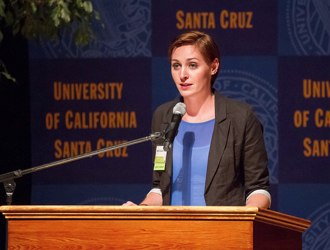
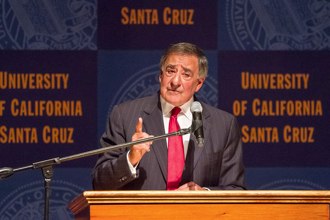
Top: Sammy joined me on Saturday. Photo by Ken Feingold. Middle: Helen Porter at Launch!. Leon Panetta drew a big crowd Friday night. Photos by Steve Kurtz.
What does it mean when campus leaders show up to meetings as Sammy the Slug? Only one thing: It must be Alumni Weekend at UC Santa Cruz.
Howard Heevner, our assistant vice chancellor of constitutent engagement, set the tone for the weekend at our Saturday morning Alumni Council meeting, and the rest of the day did not disappoint. From three outstanding faculty teach-in's ("classes without quizzes") to Mission Hill Creamery's ice cream, the lineup on Saturday had something for everyone.
The three-day celebration kicked off Friday night, when hundreds of alumni and guests attended Launch!, a celebration of the UCSC student experience and a keynote speech by Leon Panetta. The strolling dinner was a great success as guests had a chance to meet current students and heard about their work. One student participant, Helen Porter, described her four years at UCSC to the group gathered for Panetta's keynote address, and she brought down the house when she talked about everything she has done here and the depth of gratitude she feels toward those who support financial aid programs. It was a proud moment.
I was honored to introduce Panetta, a longtime friend of the campus, and I unabashedly soaked up his message of the importance of education to democracy. I loved it when he said an informed public is the key to breaking the gridlock that has paralyzed Washington, D.C., and couldn't agree more that education isn't a luxury; it's indispensable to our democracy.
The Saturday teach-in's were popular, with Alison Galloway describing her work as a forensic anthropologist (A Day in the Life of the Dead—what a great title!), biomolecular engineer Ed Green tracing the family tree of Homo Sapiens and Neandertals, and Bruce Thompson telling tales of spying and espionage during World War I and World War II.
For the third year in a row, Carolyn Lagattuta and Rob Knight staffed a photo booth, snapping souvenir 5" x 7" photos for all who posed—with or without optional Slug regalia that included feather boas, a slug mustache, fleece antennae, and bright yellow sunglasses. They even snapped a shot of proud parents with their grinning member of the Class of 2035!
Most importantly, alumni had a chance to reconnect with a special place and time in their lives. That's what Alumni Weekend is all about.
Comments or questions? Write to chancellor@ucsc.edu and put "Alumni" in the subject line
April 21, 2014
A delightful encounter with greatness

Planned Parenthood President Cecile Richards
I meet a lot of impressive people in my job, but Planned Parenthood President Cecile Richards really stands out. It doesn't hurt that she is the daughter of a hero of mine, former Texas Gov. Ann Richards, but boy, Cecile is a real presence.
We met at Planned Parenthood headquarters in New York City recently, and I liked her immediately. We talked about UCSC's leadership in feminist studies, genomics, and the ethical issues of genomics and new medical technology, including informed consent and access to care. She clearly already knew a lot about UCSC and was really grateful when I gave her a signed copy of Bettina Aptheker's memoir, Intimate Politics: How I Grew Up Red, Fought for Free Speech, and Became a Feminist Rebel.
We had a great conversation, and she opened my eyes to what she considers a "revolution in women's health" brought about by the Affordable Care Act. The majority of Planned Parenthood's clientele are between the ages of 18 and 30, and for the first time, this cohort has access to health insurance. She called this a transformative moment.
At any rate, she was enthusiastic about doing whatever she can to help the campus, as her schedule permits. I know I would be very proud to host her on campus, or to host an event in New York City that involved her. It was such a good meeting, confirming what I suspected were strong affinities between UCSC and her mission at Planned Parenthood.
If she follows in her mother's footsteps, I can say right now that I'd vote for her for president any day!
That wasn't the only highlight of my East Coast trip. We had a wonderful breakfast meeting with alumni and other friends of the campus, hosted by Christine and Robert Holo. They've been invaluable champions and supporters of UCSC, and with their help, we are building a strong network in New York City. Considerable credit also goes to Steve Weldon in University Relations, who is—sadly for us—retiring this month. Steve, congratulations, and I promise to build on your successes and carry on your good work!
Comments or questions? Write to chancellor@ucsc.edu and put "Richards" in the subject line.
April 9, 2014
Sneaking a peek at the Class of 2018
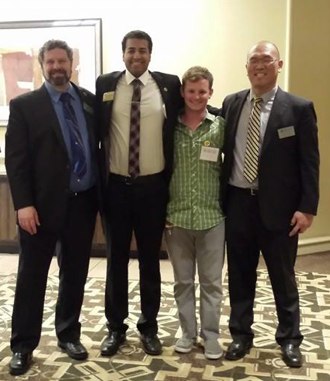
Admissions Director Michael McCawley, far left, SUA Chair Shaz Umer, left, and Admissions Outreach Representative Ben Kwak, right, grabbed a quick photo with a recent UCSC graduate at a recent reception in Long Beach for admitted students. Photo by Felicia Young.
You know what's energizing? Talking with high school seniors who can't wait to come to UC Santa Cruz this fall. Their parents are pretty fun, too, but it's the students whose enthusiasm is infectious.
Every spring, the Admissions Office hosts receptions with admitted students. I am always happy to participate, especially when I'm joined by current students, like SUA Chair Shaz Umer, who joined us last week in Berkeley, Fresno, and Long Beach.
Shaz is a great ambassador, talking about the popular airport shuttle he helped launch, the campuswide talent show he helped organize last year (and is reprising this spring), and the upcoming Edge of Eden Music Festival that SUA is cosponsoring with the Dean of Students Office. Alumni spoke at each event, too, including Berkeley City Councilmember Darryl Moore, community organizer Rebecca Rangel in Fresno (who coincidentally is running for city council), and Beverly Yanuaria in Long Beach, an academic adviser to high-achieving students at UCLA. Many other alumni attended the events, interacting with guests and sharing their stories. I wish I could thank each of them personally.
Each get-together was great—all told, more than 1,000 people turned out. I definitely noticed a couple of recurring themes during the question-and-answer sections. Everyone is focused on opportunities—to do research, work with faculty, get hands-on learning, etc.—and, as always, we fielded lots of questions about our colleges. Admissions Director Michael McCawley has the best answer for that one (based on a few years of experience). He reassures students that whichever college they pick, within a few weeks of arriving, they will be absolutely convinced their college is the best one there is!
If last week's preview is any indication, the Class of 2018 is going to be an outstanding group of new Banana Slugs.
Comments or questions? Write to chancellor@ucsc.edu and put "Admissions" in the subject line.
April 8, 2014
Kudos to Kelly
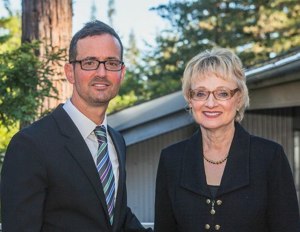
Hastings professors Morris Ratner and Kelly Weisberg teamed up to bring a fantastic program to UCSC. Photo by Christopher Dydyk.
My wife, Kelly Weisberg, does a lot for UC Santa Cruz, most of it behind the scenes, so it was pretty nice last night to see her recognized for a very public, very lasting contribution: She was the driving force behind the new 3 + 3 program with UC Hastings College of the Law in San Francisco.
Kelly is a Hastings professor, and she saw what struck her as a natural affinity between UCSC and Hastings, two campuses with enduring commitments to social justice. Thanks to her leadership, and the hard work of a number of people on both campuses, we now have a new joint program that will enable UCSC students to earn a bachelor's degree and law degree in six years instead of the usual seven. Kudos to you, Kelly!
Kelly was also the inspiration behind the new UC Hastings Social Justice Speakers Series at UCSC, which began last night with an amazing talk by Hastings Professor Morris Ratner. He is well known in legal circles for his successful prosecution of Holocaust-era private law claims on behalf of victims of Nazi persecution. What a fascinating talk—and a convincing reminder of the power of the law to bring about positive change. Who would think it would be possible to recover $8 billion in assets, most of which went to victims who were mere children during the Holocaust, and their heirs? That's the kind of bold, audacious thinking we at UCSC like.
On a final note, Kelly and I recently attended a screening in San Francisco of Anita, the new documentary about Anita Hill, who famously accused Supreme Court nominee Clarence Thomas of sexual harassment during his 1991 Senate confirmation hearings. The really striking – and lesser known -- thing about Hill's life is that she has spent most of the intervening years fighting to safeguard the rights of women and men in the workplace. She has worked tirelessly to put in place sexual-harassment protections so others don't have to endure what she experienced. Another story of using the law for good. One side note: Guess who served on Hill's defense team? None other than Janet Napolitano, current president of the University of California. If you watch Anita, keep an eye out for her.
Comments or questions? Write to chancellor@ucsc.edu and put "Ratner" in the subject line.
February 14, 2014
Lunch with the Dalai Lama
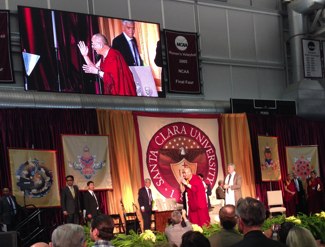
I snapped a photo of the Dalai Lama -- and his image on the jumbo screen -- with my iPhone.
|
Santa Clara University President Michael Engh kindly invited a guest and me to the Dalai Lama's appearance at Santa Clara University yesterday. I had no idea how extraordinary it would be.
Mary-Beth Harhen, executive director of the Academic Senate, and I attended an intimate lunch with the leader of Tibetan Buddhism, followed by his public appearance. I was quite taken aback by what happened. When he first walked into the room, he walked straight to me—before anyone else—and gazed into my eyes. It felt like he was looking straight into my soul. I've never experienced anything like it. Mary-Beth, a longtime follower of Tibetan Buddhism, said the Dalai Lama is known for connecting deeply with people in a way that "fully encompasses" them. I daresay that's how it felt. I'm still reflecting on the encounter, even as I head to Hawaii to chair a meeting of the California Association for Research in Astronomy (CARA).
One note about choosing Mary-Beth to accompany me to the events with the Dalai Lama: Her reaction assured me I'd extended a welcome invitation. "That big swishing sound you hear are the tears of joy rising up from the first floor of Kerr Hall," she said.
Comments or questions? Write to chancellor@ucsc.edu and put "Dalai" in the subject line.
February 14, 2014
Students invite a UC Regent to campus

UC Regent Fred Ruiz, top, met with UCSC students involved in our Engaging Education outreach program. SUA Chair Shaz Umer, middle, and External Vice Chair Tony Milgram teamed up on a great event.
|
What's on the minds of our students? Tuition, access, affordability, programs, and the budget, if the questions I got during last week's "Appetizers with Administration" event is any indication.
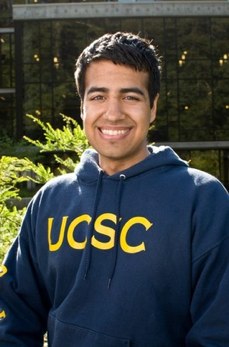
And that's just what students asked me. My colleagues fielded questions about UC's new smoke-free policy, student leadership opportunities, the preparation of student residential assistants, and more.
I have to tip my hat to the SUA leaders who organized the get-together at University House. SUA Chair Shaz Umer brought up the idea to me, and External Vice Chair Tony Milgram took it up a notch by inviting UC Regent Fred Ruiz. Tony is the student observer to the Regents' Committee on Finance, which Ruiz chairs, so Tony showed great initiative inviting Ruiz, who hadn't been to UCSC in quite some time.
It was an impressive turnout, and students majoring in an incredible range of subjects showed up: politics, biochemistry, education, theater, feminist studies, Spanish literature, math, psychology, electrical engineering, neuroscience, global economics, sociology, film and digital media, computer science, and technology and information management. Thanks also to Campus Provost/EVC Alison Galloway, vice chancellors Sarah Latham of Business and Administrative Services, Scott Brandt of the Office of Research, and Richard Hughey of Undergraduate Education, as well as Jean Marie Scott of Risk and Safety Services and Linda Beaston of the EVC's office, for spending time – and sharing appetizers -- with our students. It was fun.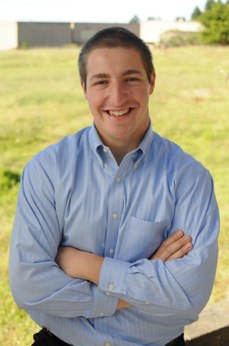 The event capped a day-long visit for Ruiz, who met with students, campus diversity officers, and others. He was so impressed with our students, describing them as engaged, enthusiastic, and full of great ideas, especially about diversity. Ruiz cosponsored the Regents Study Group on Diversity, so he knows a lot about the topic. He was impressed by what we're doing at UCSC, which is saying a lot, because he's quite critical of UC's overall track record on faculty diversity. I always remind him that faculty diversity levels change slowly, but we at UCSC are poised to see the pace of change pick up in the next few years as a wave of retirements washes over the campus. Those openings will provide an opportunity for us to further diversify our faculty. That's a change that will be good for our students and the campus as a whole.
The event capped a day-long visit for Ruiz, who met with students, campus diversity officers, and others. He was so impressed with our students, describing them as engaged, enthusiastic, and full of great ideas, especially about diversity. Ruiz cosponsored the Regents Study Group on Diversity, so he knows a lot about the topic. He was impressed by what we're doing at UCSC, which is saying a lot, because he's quite critical of UC's overall track record on faculty diversity. I always remind him that faculty diversity levels change slowly, but we at UCSC are poised to see the pace of change pick up in the next few years as a wave of retirements washes over the campus. Those openings will provide an opportunity for us to further diversify our faculty. That's a change that will be good for our students and the campus as a whole.
Comments or questions? Write to chancellor@ucsc.edu and put "Ruiz" in the subject line.
January 31, 2014
UCSC's ripple effects are felt far and wide
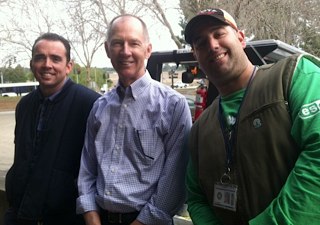
Among the staff I met during a workplace tour were (l - r) automotive technician Seth Sanders, senior custodial supervisor Craig Mortensen and locksmith Tony Bosso. Photo by Renee Mayne.
My week started with a powerful reminder of how impactful UCSC people are in the world. The memorial service on Saturday for music professor Fred Lieberman was an incredible testament to a man whose interests and talent literally reached around the world.
I was struck by Fred's intellect, insatiable curiosity, and tireless drive to learn. He was involved in so many projects around the globe. On campus, he's widely recognized for his collaborations with Grateful Dead drummer Mickey Hart, who spoke at the memorial, and he is certainly responsible for UCSC acquiring the Dead's vast archives. His scholarly contributions were equally monumental, including a seminal paper he wrote in the 1970s about the prospect of abolishing the field of ethnomusicology. Fred was a mover and shaker in his field, a mentor to many, and an inspiration to all who knew him. I wish I had known him better.
Two alumni were in the news this week, too. Santa Clara County has named UCSC alum David Perez to a two-year term as Poet Laureate. This is the latest accolade for David, who earned a BA in literature from Kresge College in 2003. In 2012, he was voted "Best Author in the Bay Area" in the San Francisco Bay Guardian's annual readers' poll. He is the author of Love in a Time of Robot Apocalypse, among other works. He teaches English at Ohlone College.
And alum Ryan Seelbach, who earned a BA in Earth Sciences in 1992 and a master's the following year, made the first semi-final round in the recent Body Glove Mavericks Invitational surfing contest. If you've seen any video of the contest, you know it takes courage to ride those monster waves. At UCSC, our alumni make waves -- and ride them, too!
Two other highlights of my week: I met with members of the Student Union Assembly on Tuesday night and was impressed by their questions and engagement, particularly around philanthropy and the support services we provide for students.
The next day, Alison Galloway and I toured the Cogeneration Plant and Physical Plant facilities as part of our ongoing "walk a day in our shoes" outreach to staff. I can't believe I'd never seen our old diesel generator before. Talk about a workhorse! Salvaged off a submarine, it has performed admirably but is about to be replaced by a sleek, modern unit powered by natural gas. None too soon, according to the talented team that's been keeping it online—sometimes by machining replacement parts in their own shop. I also had no idea the variety of vehicles our mechanics service—cars, shuttle buses, trucks, vans—even the OPERS climbing wall was in the shop for a tune-up! And I confess that I got a kick out of going behind the counter at the TAPS window. I was always careful to time the pick-up of my parking pass to avoid those long lines. These tours are a great way to see more of the campus and to learn from the staff who keep this entire campus – including that old generator – running smoothly.
Comments or questions? Write to chancellor@ucsc.edu and put "Lieberman" in the subject line.
January 24, 2014
Lunch with a legend
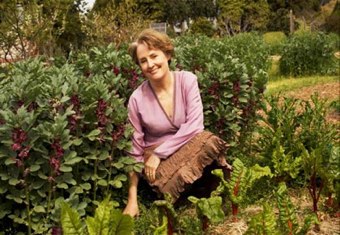
How has legendary chef and pioneer of the local, organic food movement Alice Waters achieved so much? That's the question we posed to her during a recent lunch at Chez Panisse, her renowned restaurant in Berkeley. Alice's answer? You have to want it all. Take an uncompromising approach and don't settle for anything less.
What a refreshing and energizing approach. I'm pretty sure Daniel Press, professor of environmental studies and director of our Center for Agroecology and Sustainable Food Systems, had the same reaction when he heard those words. We were lunching with this legend thanks to an invitation prompted by campus friends Alec and Claudia Webster, great champions of the Center's work and UCSC's leadership in sustainable agriculture, who joined us, along with Daniel's wife Sarah.
Alice knows a lot about UCSC's work – she has hired a number of graduates of our Apprenticeship in Ecological Horticulture over the years -- and she is eager to learn more. We hope to get her down for a visit this fall. Among her passions is a desire to improve the quality of school lunches, building on the success of her Edible Schoolyard program in Berkeley. She appreciates UC's commitment to buying produce from local organic farms and seemed to recognize UCSC as a kindred spirit in many ways.
All in all, it was quite a treat. And the goat cheese, nettle pizza? Outstanding!
Comments or questions? Write to chancellor@ucsc.edu and put "Alice" in the subject line.
January 16, 2014
Koalas, kangaroos, and more
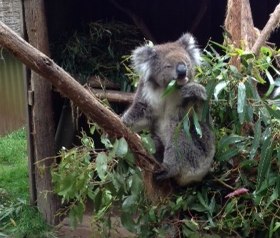
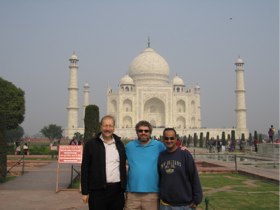
Koalas are indisputably cute, and the Taj Mahal was stunning.
Lions, tigers, and bears? How about koalas, kangas, and roos?
My wife and I took our two adult children to Australia before I split off to meet up with the UCSC delegation in India. It was a great trip, and I can now attest to the cuteness of koalas and kangaroos.
This was my first trip to India, and like every other visitor, I was struck by the sights, sounds, and smells of this nation teeming with people and energy. We had an agenda packed with meetings from Delhi and Punjab in the north to Bangalore in the south, and it was gratifying to see the high level of interest in our campus among educators, government officials, and prospective students. We made good progress on multiple initiatives that I'm confident will benefit the campus.
We did take a couple of breaks during the trip. Admissions Director Michael McCawley and I took time out for a bicycle rickshaw tour of Old Delhi. Michael and I are both pretty big guys, and I'm a little embarrassed to say that our driver actually had to dismount and push the bike the last few blocks. I guess "lose weight" should be on my list of resolutions for 2014!
In many ways, India struck me as a country of contrasts. The disparity between wealth and poverty was inescapable. It was particularly striking at the Taj Mahal, where we marveled at the beauty of the building -- and at the suffering of those who live close by.
Yet throughout the trip, I detected an extraordinary level of optimism everywhere we went; a spirit of entrepreneurship seemed to infuse every conversation and interaction. One impression has really stuck with me: Absolutely everyone has a cell phone, even people who appeared to be living in the most dire circumstances. The tendrils of technology have indeed reached into every nook and cranny of our world.
Comments or questions? Write to chancellor@ucsc.edu and put "Koalas" in the subject line.
